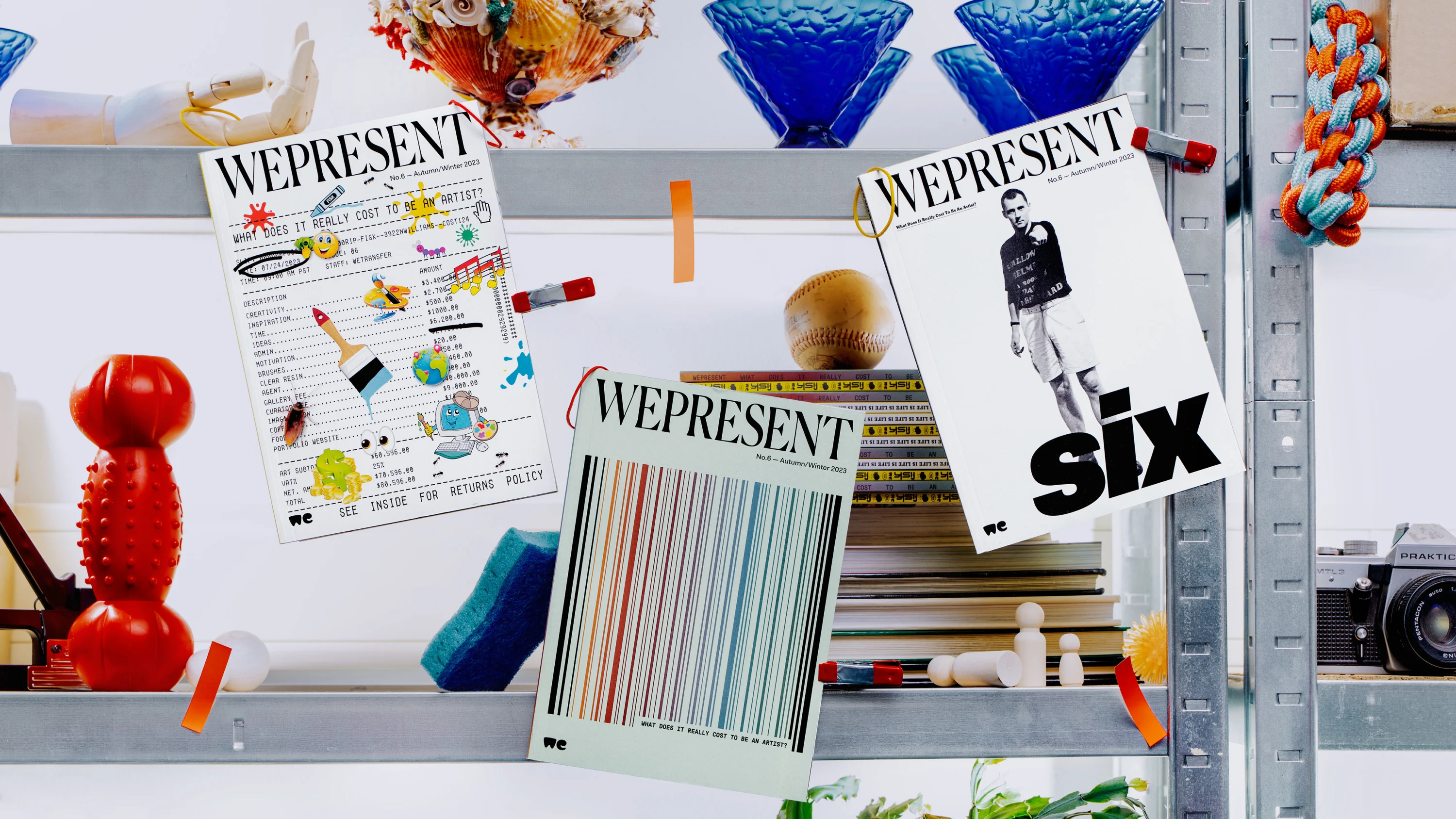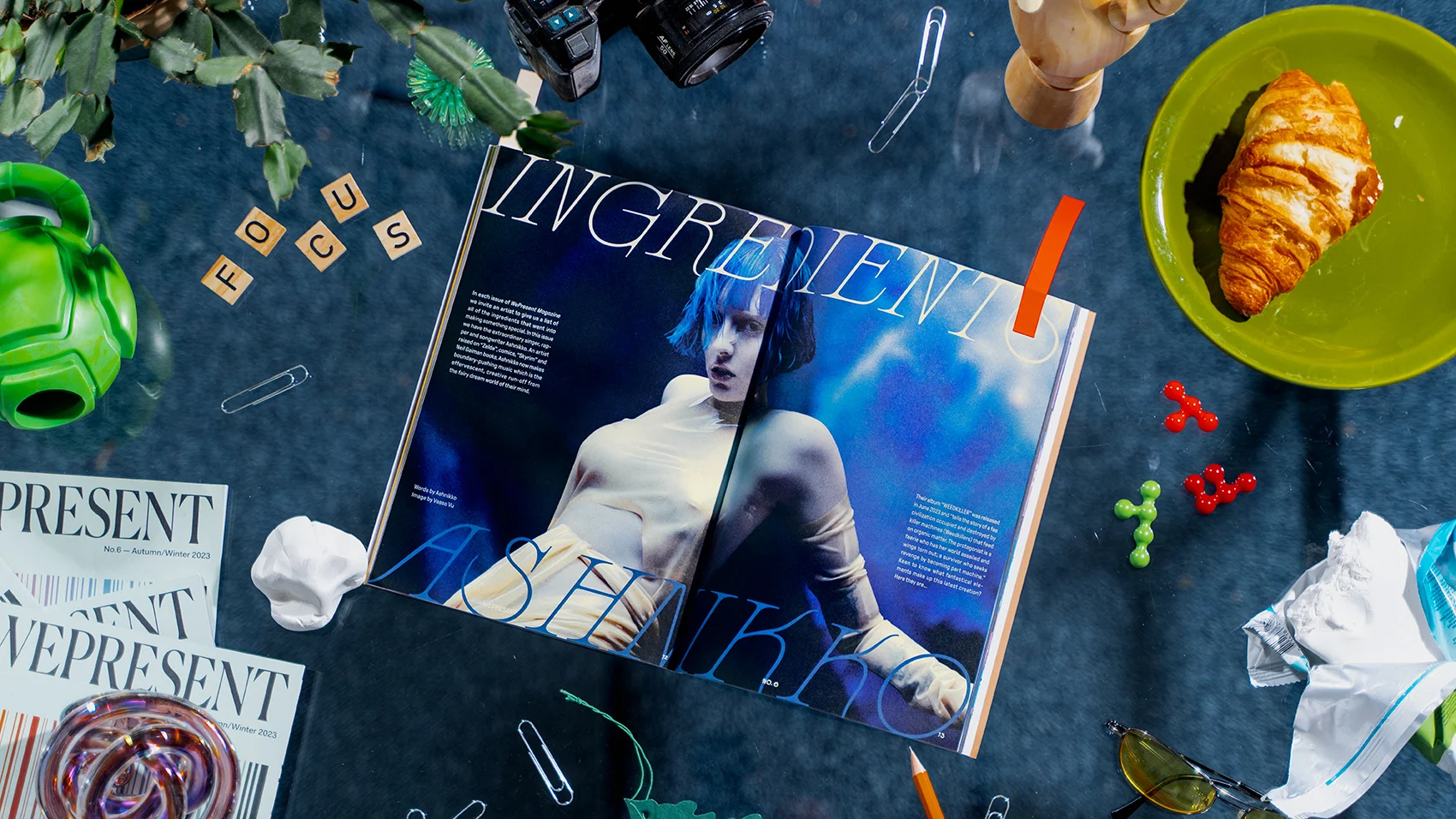

The latest issue of our bi-annual printed publication WePresent magazine is now out in the world. Here WePresent’s Senior Editor Liv Siddall explains what’s in this issue, a little more about the magazine’s three-designers-one-issue concept, and most importantly, where you can get your hands on a copy of the latest issue. If you can’t wait, just head over here to MagCulture to snag a copy now.
Back in 2021, a few of us at WeTransfer gathered together to prepare to give WePresent’s printed offering, WePresent Magazine, a makeover. Maybe even more than a makeover… A transformation. A lot changed. Fundamentally, we went from creating a heavy, doorstop, annual publication, to a wee bi-annual, digestible enough that you could pop in your bag to read on the bus home.
But we needed another angle. A theme or a challenge that would dictate not just the size of the magazine, but what was inside. In a time where making something new, or something true, has never been more difficult, we decided to try out an idea that spoke to our interests. Wanting the magazine to be as representative and as global as possible, and to truly be creative, as opposed to just be about creativity, we embarked on inviting not one but three designers to design each issue, creating three different versions of the same magazine. As anyone who has ever made a magazine knows, making one is hard enough, what kind of masochist would willingly make three?
Us, it seems. But it turns out it wasn’t as grueling as it sounds. In fact, it’s been really great. Illuminating, in fact. So much of design, like anything in the cultural sphere, is fed by the echo chamber within which it resides. Different brands will hire the same creative researchers, who bring the same cultural touchstones and reference points to the brainstorms. Even if the people bringing the ideas have had vastly different lives, chances are they’re getting fed the same images of interiors, record sleeves and street style as everyone else bringing ideas to work. Social media dictates that we should all be drinking from the same communal soup, or fishing from the same pond, leading to a lot of adverts, brand identities, magazines or fashion collections being ever so slightly reminiscent of something else.
We quietly hoped that inviting three designers from all over the world to design the magazine would make the magazine beautifully global: that the locations and lives of these creative people would in some way bleed into the pages themselves. And that would, in turn, make it original. Diversity of ideas, people and work has always been a cornerstone in what we do and make, but too often we focus too much on who we are featuring, as opposed to who’s making the actual thing itself.

For our first edition, Issue 4, we invited Seri Tanaka, an art director and graphic designer in Japan, Chloe Scheffe, a fantastic editorial designer and art director based in Seattle, and Slovenian multidisciplinary graphic designer, art director and teacher Nejc Prah to take part. For Issue 5 we asked Eike Koenig, a world-renowned designer in Berlin who founded the brilliant design studio Hort and Turbo, a small but wonderful studio in Amman, Jordan. And finally a true legend of the graphic design world, Pentagram Partner Paula Scher, who lives and works in New York City.
For the latest issue of WePresent Magazine, we commissioned FISK: a Portland-based graphic design studio who create “thoughtful experiences for physical and digital spaces in collaboration with clients, friends, artists and the greater community”, and Polymode, a “bi-coastal, queer, and minority-owned graphic design studio leading the edge of design with thought-provoking work for clients across the cultural sphere.” Last but not least, our third designer for this issue was Gustavo Eandi, a designer based in Mar del Plata in Argentina who has created intelligent, informed, subversive work for some of the coolest record labels, fashion brands and publishers in the world.

In WePresent Issue 4 we learned a lot about who the designers were: how they worked, what they were into, and what inspired and motivated them. In Issue 5 we decided to build on that, and make the whereabouts of each designer at the forefront of the magazine, even asking them to create their own feature called “My Neighborhood” about where they lived. For Issue 6, the theme of which is “endurance”, we invited the designers to create a time capsule feature in the magazine that, in 1000 years, would communicate what they were about to whoever read it.
The process of working with the designers has been honed but has remained pretty unchanged over the last few years. Fundamentally, we share with them a folder of around 15 features in text-only Google Docs. All features come with a title, an intro and some pull quotes. Some come with images, some do not. Most are articles that have already been published on WePresent, some are exclusive to the printed magazine. The designers are also given a cover template with a boilerplate, the dimensions of the final printed publication, and a brief to make an advert on the back cover (for Issue 6, we asked them to create an advert celebrating an unsung hero of the natural world). The brief from then on is just to somehow turn these ingredients into a magazine.
Provided you are working with a good designer (luckily, we always have), seeing a designer’s interpretation of the editorial content of any magazine is one of the great joys of publishing. Just like waiting to get an envelope of holiday snaps back from the photo lab, waiting to see what our three designers had conjured up for each issue is a total thrill. We arranged regular check-ins with each design studio, hearing about how Gustavo Eandi was inspired by classic magazines from the golden age of publishing, or how Polymode wanted to inject a subconscious but deep energy and rage into their design, and how FISK wanted to shoehorn a (cute) cockroach in there to symbolize the end of the world as we know it.
We love the idea that our version of the magazine will resonate differently with readers, but that the content is consistent.
Witnessing how all the designers created wildly different features to one another was made all the more fun knowing that, during the process, they are all fascinated by what the other designers might be simultaneously thinking or doing. During our check-ins, some designers would say things like: “I would do this on the cover, but I imagine one of the other designers has already thought of that.” (Disclaimer: the other designers would never have thought of doing that).

What they expected each other might do was always so wildly far off the mark. It was interesting—and amusing—to see them all assuming they were on the same page, or had gone down similar routes, when actually the truth was so far from it. “We love the idea that our version of the magazine will resonate differently with readers, but that the content is consistent,” say FISK of their iteration. “This is such a fun facet of the project, that demonstrates the infinite canvas of a designer, that a brief can have so many unique outcomes. In this case, it represents the unique lens of an individual, or collective studio in our case.”
Each of us represents a different point of view. As a reader and consumer, I’m grateful for that.
Gustavo agreed with the opportunity for individuality that the brief offered. “Working on the mag was super easy because I felt it like [was] ‘my own’ magazine,” he explains. “Beyond [that], the other two studios are amazing, [so] I worked with zero pressure because I knew each of us has a distinctive style, and [would make] a distinctive final product. Each of us represents a different point of view. As a reader and consumer, I’m grateful for that.”

But that’s been one of the biggest surprises in this design experiment: the fact that three issues in, with nine versions of three magazines under our belt, not one publication has been born out of design trends. We have watched nine designers take folders of text-only Google docs and a handful of images turn them into not just magazines but almost self-portraits. This was something that really resonated with Polymode. “Knowing that other designers were doing their version in their own way excited us,” they said. “One of the main reasons we became designers is to put our imprint on our work. Processing information differently and uniquely is what makes us more human. To offer choices and differences with the same information is liberating. There is room at the table for everyone, so why not let that representation shine by honoring, celebrating, and uplifting differences?”
There is room at the table for everyone, so why not let that representation shine by honoring, celebrating, and uplifting differences?
For a lot of the designers, they were vocal about how much they were enjoying being given the opportunity to just do what they wanted for a change, being told they had ultimate creative freedom. Provided they ran the cover designs by us and kept us in the loop with their design route, the rest was up to them. “A project like this feels like a sort of award, in that it allows us to explore non-commercial graphic design in a traditional format for a commercial client,” says FISK of their work on Issue 6. “WePresent’s brief for FISK was to be FISK. Work like this is representative of our studio practice and serves as a playground for graphic design to feel a bit more like art.”

Like any creative profession, but very much in graphic design, you may set out in your career thinking you’ll be designing record sleeves, but the reality is often supermarket labels. Or, when something creative does come along, the client can micromanage it within an inch of its life, snuffing out its potency and decimating it of any potential enjoyment with regards to the process. “The client usually gets to say ‘this’ way versus ‘any way you want’ due to footing the final bill,” Polymode say. “It takes a lot of trust for any commissioner to let go and allow the creative spirit to take root and develop something beautiful. We feel that it’s pretty rare we are given this level of freedom, though it does happen with a few clients with whom we’ve built that trust.”
To give nine different designers the chance to just play around and make something how they wanted to make it, has been an honor and a pleasure. “[To] receive that email felt like a breeze of fresh air, like a free pass to play,” Gustavo says. “An invitation to go back in time, to use the scissors, the A4s and a Xerox machine for making my own zine again.” FISK agreed. “Working on a project like this is a necessary exercise and breath of fresh air amongst traditional client projects,” they said. “We interpreted the brief as a studio self-portrait, what are we most excited to make at this moment and will best showcase the breadth of our interests, past and present.”
For us, collaborating with extraordinarily talented writers and artists on making these stories on WePresent is a joy in itself. To then hand those to some of the world’s best designers to reimagine in whatever way they see fit, is almost just greedy. But it makes sense for us. It’s a project that invites collaboration, conversation and freedom and that highlights individuality and the importance of keeping creativity as global as can be. Oh, and we just really love magazines. But who doesn’t?
In stores now
If you’d like to pick up a copy of your own, you can find them via the links below:


